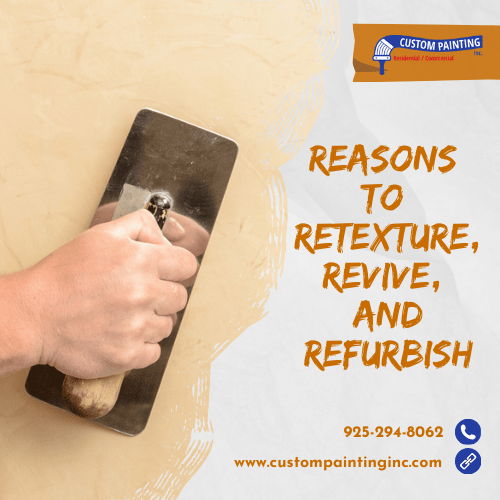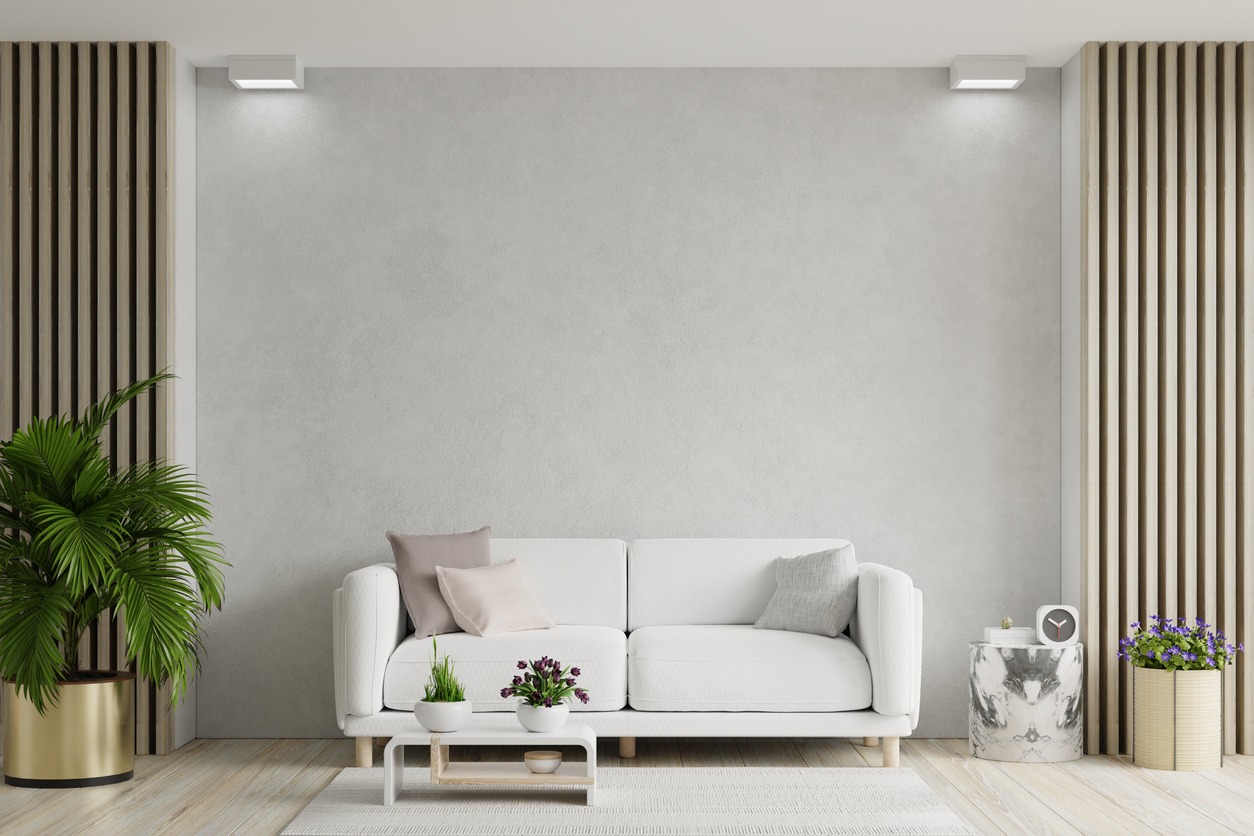What’s the perfect time to update your home’s interior spaces? The answer: anytime is a good time to do interior painting at your Livermore home, especially before the gloomy months occur.
If you feel your interior walls look boring or lack something interesting, why don’t you give them some texture? It will create a unique look and visual interest for your home’s interior spaces. But if you want to add texture but don’t know where to start, let this article guide you how.
Reasons to add texture to your interior walls
Adding texture to interior walls can enhance a space’s aesthetic and functional aspects in several ways. Here are some reasons to consider adding texture to your interior walls:
1. Visual interest and depth
- Enhanced aesthetics – Textured walls create visual interest and can make a space feel more dynamic and engaging.
- Depth and dimension – Textures add depth to flat surfaces, making the room feel rich and layered.
2. Concealing imperfections
- Hiding flaws – Textured walls can mask minor imperfections, such as cracks, dents, or uneven surfaces, which would be more noticeable on smooth walls.
- Surface uniformity – A textured finish can help blend inconsistencies in wall surfaces, providing a more uniform look.
3. Acoustic benefits
- Sound absorption – Certain textures can help reduce noise levels by absorbing sound waves, leading to a quieter environment.
- Reduced echo – Textured surfaces can minimize echo and reverberation, especially in larger rooms or spaces with high ceilings.
4. Tactile experience
- Touch sensation – Adding texture can make walls feel more stimulating to touch than smooth walls, enhancing the overall sensory experience of the room.
- Material exploration – Different textures invite people to explore the space through touch, making the environment more interactive.
5. Stylistic expression
- Custom design – Textures allow for greater customization and personalization, enabling homeowners to express their unique style.
- Thematic consistency – Textured walls can complement specific interior design themes, such as rustic, industrial, or Mediterranean styles.
6. Lighting enhancement
- Light play – Textured surfaces interact with light differently than smooth ones, creating interesting shadows and highlights that change throughout the day.
- Ambient effects – The interplay of light and texture can enhance the ambiance, making the room feel cozier or more dramatic, depending on the desired effect.
7. Practical advantages
- Durability – Some textured finishes, like stucco or plaster, can be more durable and resistant to wear and tear than flat paint.
- Maintenance – Textured walls can be easier to maintain, as they often hide dirt and smudges better than smooth walls.
8. Historical and Cultural Relevance
- Authenticity – Textured walls are essential for maintaining authenticity and historical accuracy in certain architectural styles or historical restorations.
- Cultural significance – Textures can reflect cultural elements, such as traditional plasterwork in Mediterranean or Middle Eastern interiors.
Incorporating texture into your interior walls can transform the look and feel of your space, providing both aesthetic and practical benefits. Whether aiming for a subtle, sophisticated effect or a bold, dramatic statement, textured walls can significantly enhance your home’s interior design.
Common types of wall texture
There are several types of texturing for interior walls, each offering a unique aesthetic and feel. Here are some common types:
- Smooth finish – The wall is sanded to a flat, even surface.
- Orange peel – A subtle texture resembling the surface of an orange peel.
- Knockdown – A mottled texture achieved by spraying and then smoothing down.
- Skip trowel – A hand-applied texture with a random, rustic look.
- Sand swirl – Circular or arched patterns made with a brush or trowel.
- Slap Brush – A texture created by slapping a brush against the wall.
- Popcorn – A bumpy texture often used for ceilings but occasionally for walls.
- Stucco – A coarse, cement-like finish commonly used for exterior walls but sometimes used indoors.
- Venetian plaster – A smooth, glossy finish mimicking marble’s appearance.
- Brush textures – Various patterns are created using different types of brushes.
- Lace texture – A delicate, lace-like pattern applied using a hopper gun.
You can choose from these texturing techniques to add visual interest, hide imperfections, or achieve a specific design style in interior spaces.
Selecting and applying new texture to walls
Selecting and applying a new texture to interior walls involves several steps to ensure the desired aesthetic and a professional finish. Here’s a brief guide:
Selection:
- Assess the room: Consider the room’s purpose, size, and existing décor. Some textures can make a room feel cozier, while others add elegance or a contemporary look.
- Material compatibility: Ensure the texture’s material suits your wall type (drywall, plaster, etc.).
- Sample testing: Apply small samples of different textures to a wall’s section to see how they look in the actual lighting and space.
- Skill level: Consider your DIY skill level. Some textures are more complex and may require professional application.
- Maintenance: You must think about how easy it is to clean and maintain the texture, especially in high-traffic areas.
Application:
1. Preparation:
- Clean the walls: Remove dust, dirt, and grease.
- Repair imperfections: Fill holes and cracks with spackle or joint compound.
- Sand the Surface: Smooth out any rough areas.
2. Priming:
- Apply a coat of primer suitable for your wall surface to ensure better adhesion of the texture.
3. Mixing:
- Prepare the texture material according to the manufacturer’s instructions. It could be a pre-mixed product or a product that requires mixing with water or other additives.
4. Application methods:
- Roller: Use a textured roller for an even application.
- Spray gun: Ideal for more uniform and faster application over large areas.
- Trowel or knife: For hand-applied textures like skip trowel or Venetian plaster.
- Brushes: These are used to create patterns like sand swirls or slap brushes.
5. Finishing:
- Allow the texture to dry completely.
- If desired, paint over the texture with a suitable interior paint to achieve the final look.
Tips:
- Practice first: Try the texture technique on a piece of scrap drywall or cardboard to perfect your technique.
- Follow instructions: Adhere to the product instructions for mixing and application times.
- Consistent application: Ensure even coverage and consistency in texture to avoid patchiness.
Carefully select the right texture and follow proper application techniques. It allows you to enhance your interior walls’ visual appeal and character.
It’s time for new paint – and a new wall texture!
Do you consider painting your home’s interiors? Change wall texture due to cracks or just for a new look. Retexturing is a cost-effective way to adorn and enhance your space. Both texturing and painting require similar wall prep steps. After cleaning, repairing, and priming walls, you should add texture before painting for a fresh look.
Taking the DIY route may help save some money initially, but it is possible to make mistakes, especially if you haven’t tried applying texture to walls before. Let Custom Painting, Inc. professionals do the work to make your home a more inviting space. Retexturing your home’s interior surfaces creates a bright and warm haven from the cold, a welcoming reprieve where “stylish elegance” isn’t a mere word describing someone’s living space. When you choose Custom Painting, Inc. to revive your interior spaces, we know we will revive and rescue your mood! You can pick up the phone and give us a call today at 925-294-8062 or complete our contact form to retexture your walls that revive, refresh, and refurbish.



